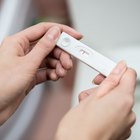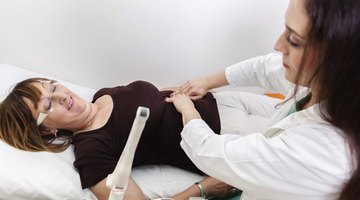How to Get Pregnant With Thick Uterine Lining
When the uterine lining is too thick, it cannot support implantation of the fertilized egg and result in pregnancy. As a result, treating a too-thick uterine lining can improve your chances of conception.
Uterine Lining and Your Fertility
The uterine lining, the endometrium, is where a pregnancy begins. Once the egg has been fertilized by the sperm, the egg attaches to the uterine lining, thereby achieving pregnancy. This process, known as implantation, begins the development of the fertilized egg into a baby.
Thick Uterine Lining
Several factors can result in a thick endometrium, a condition called endometrial hyperplasia. The thickness of the uterine lining changes throughout a woman's monthly cycle, and hormones dictate how thin or thick this lining is at any given point in the cycle. Hormonal imbalances may result in a too-thick endometrium.
The American Congress of Obstetricians and Gynecologists explains that too much estrogen without progesterone is the most common cause of a thick endometrium. For example, if a woman doesn't ovulate, her body doesn't produce progesterone but continues to produce estrogen, which can result in buildup of uterine lining.
Factors that may trigger this imbalance of hormones including an anovulatory cycle, include menopause, estrogen-heavy medications, irregular periods and polycystic ovary syndrome.
When you're trying to conceive, a too-thick endometrium may inhibit the implanation of the fertilized egg, which means pregnancy may be more difficult to achieve.
Treatments

The Medical Conditions That Cause a False Positive in Pregnancy Results
Learn More
Your obstetrician or reproductive endocrinologist can determine the thickness of your endometrium during a hysteroscopy or transvaginal ultrasound. During a hysteroscopy, a thin scope is gently inserted into the vagina, through the cervix and into the uterus. For the less invasive transvaginal ultrasound, a small device is placed into the vagina that measures sound waves, converting them to images. However, the ultrasound cannot detect cancer, as the hysteroscopy can. Sometimes endometrium hyperplasia can lead to cancer, so your doctor may want to do a hysteroscopy.
Tips
Your doctor will determine what level of endometrium thickness is considered abnormal. However, typical normal ranges include 8 to 13 mm, while a uterine lining thicker than 15 mm might reduce your chances of conception.
Medications
Once your doctor has confirmed during a hysteroscopy or ultrasound that your uterine lining is thick, a prescription medicine can help you thin the endometrium and, as a result, improve chances of conception. Progestin, a synthetic version of the hormone progesterone, is a common treatment. According to the ACOG, medication is available that can be taken by mouth, in a shot, through an intrauterine device or applied as a vaginal cream.
Stimulating ovluation is another possible way to indirectly thin the endometrium, since ovulation triggers progesterone. According to Southern Ontario Fertility Technologies, some doctors may try triggering ovulation with a drug such as letrozole or clomiphene. Ovulation results in progesterone, which then results in more balanced hormones that may thin the endometrium.
Tips
Work with your doctor to find the right treatment for a thick uterine lining. Some women may be able to achieve pregnancy with prescription treatments, while others may require additional fertility treatments, such as IUI or IVF, to conceive.










